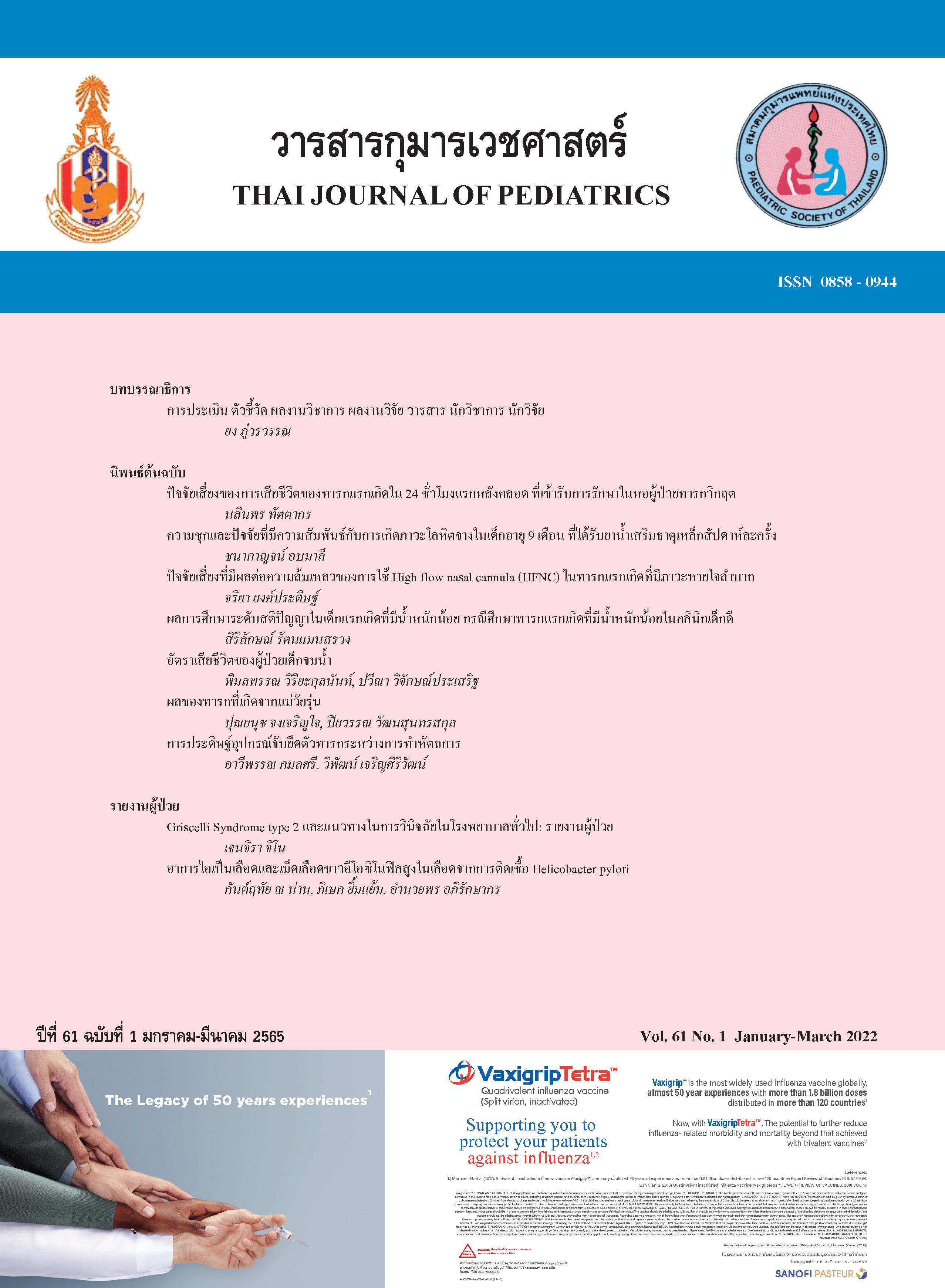ปัจจัยเสี่ยงที่มีผลต่อความล้มเหลวของการใช้ High flow nasal cannula (HFNC) ในทารกแรกเกิดที่มีภาวะหายใจลำบาก
คำสำคัญ:
High flow nasal cannula, ภาวะหายใจลำบากในทารกแรกเกิดบทคัดย่อ
ความเป็นมา: High flow nasal cannula (HFNC) เป็นอุปกรณ์ช่วยหายใจที่นิยมในปัจจุบันแต่ยังไม่มีข้อมูลเรื่องการศึกษาเกี่ยวกับประสิทธิภาพและความปลอดภัยของการใช้ HFNC ในทารกแรกเกิดที่มีภาวะหายใจลำบาก
วัตถุประสงค์: ศึกษาปัจจัยเสี่ยงที่มีผลต่อความล้มเหลวของการใช้ HFNC ในทารกแรกเกิดที่มีภาวะหายใจลำบาก เปรียบเทียบผลการรักษาและภาวะแทรกซ้อนของทารกกลุ่มที่ใช้ HFNC ล้มเหลวกับกลุ่มที่ใช้ HFNC แล้วสำเร็จ
วิธีการศึกษา: Rctrospective case-control study โดยรวบรวมข้อมูลเวชระเบียนทารกแรกเกิดที่ admit NICU ตั้งแต่วันที่ 1 ตุลาคม พ.ศ. 2559 -28 กุมภาพันธ์ พ.ศ. 2564 ด้วยเรื่องภาวะหายใจลำบากได้รับการรักษาเริ่มต้นด้วย HFNC มาวิเคราะห์ข้อมูลทางสถิติเพื่งหาปัจจัยเสี่ยง เปรียบเทียบผลการรักษา
และภาวะแทรกซ้อน
ผลการศึกษา: ทารกทั้งหมด 217 คน อัตราการล้มเหลวจากการใช้ HFNC 29.5% พบอุบัติการณ์มารดามีภาวะขี้เทาในน้ำคร่ำ (MSAF) ทารกเป็น MAS และ PPHN แตกต่างกันอย่างมีนัยสำคัญในกลุ่มทารกที่ใช้ HFNC สำเร็จและล้มเหลว ในกลุ่มที่ใช้ HFNC แล้วล้มเหลวมีปัญหา hypoxia มากกว่าจึงมี oxygen
saturation ต่ำกว่าและใช้ HPNC seting Fi02 มากกว่ากลุ่มที่ใช้ HPNC แล้วสำเร็จ ผลเลือดของทารกกลุ่มที่ใช้ HFNC แล้วล้มเหลวมีค่าเฉลี่ยปริมาณเม็ดเลือดขาวต่ำกว่า แต่ค่าเฉลี่ย CRP อายุ 6-23 ชั่วโมงและ CRP อายุ 24-48 ชั่วโมงมากกว่ากลุ่มที่ใช้ HPNC สำเร็จ ภาวะ MAS, PPHN เป็นปัจจัยเสี่ยงอย่างมีนัยสำคัญ
ต่อการรักษาด้วย HFNC แล้วล้มเหถว กลุ่มทารกที่ใช้ HFNC แล้วล้มเหลวมี Air leak syndrome และต้อง refer ออกไปรักษาต่อเนื่อง จำนวนวันที่ใช้เครื่องช่วยหายใจ ใช้ออกชิเจนและวันนอนโรงพยาบาลมีมากกว่ากลุ่มที่ใช้ HPNC แล้วสำเร็จอย่างมีนัยสำคัญ
สรุป: ทารกที่มีภาวะ MAS และ PPHN มีความเสี่ยงสูงในการใช้ HFNC แล้วล้มเหลว ซึ่งอาจสังเกตได้จากทารกมีปัญหา hypoxia มากและใช้ HFNC seting F:02 สูงควรเลือกใช้การช่วยหายใจด้วยวิธีอื่นๆ เช่น NIPPV หรือใส่ท่อช่วยหายใจ
Downloads
เอกสารอ้างอิง
Warren JB, Anderson JM. Newborn respiratory disorder. Pediatr Rev.2010;31:487-95.
Edwards MO, Kotecha SJ, Kotecha S. Respiratory distress of the term newborn infant. PaediatrRespir Rev.2013; 14:29-36.
Kumar A, Bhat B. Epidemiology of respiratory distress of newborns, Indian Journal of Pediatrics 1996; 63:93-8.
วราภรณ์แสงทวีสิน,วิบูลย์กาญจนพัฒนกุล,สุนทรฮ้อเผ่าพันธ์และคณะ. Respiratory Distress andRespiratoryDistressSyndrome.ปัญหาทารกแรกเกิด. กรุงเทพ:ธนาเพลส,2550; 97-109.
Hillman N, Jobe AH. Noninvasive strategies for management of respiratory problems in neonates, Neoreviews 2013; 14(5):e227-36.
Dani C, Pratesi S, Migliori C, et al. High flow nasal cannula therapy as respiratory support in the preterm infant. Pediatr Pulmonol
;44:629e34.
Osman M, Elsharkawy A, Abdel-Hady H. Assessment of pain during application of nasal-continuous positive airway pressure and heated, humidified high-flow nasal cannulae in preterm infants. J Perinatol 2015;35:263e7.
Klingenberg C, Pettersen M, Hansen EA, et al. Patient comfort during treatment with heated humidified high flow nasal cannulae versus nasal continuous positive airway pressure: a randomized cross-over trial. Arch Dis Child Fetal Neonatal Ed 2014;99: F134e7.
Mardegan V, Priante E, Lolli E, et al. Heated, humidified high-flow nasal cannulae as a form of noninvasive respiratory support for preterm infants and children with acute respiratory failure. Am J Perinatol 2016;33:1058e61.
Manley BJ, Owen LS. High-flow nasal cannula: mechanisms, evidence and recommendations. Semin Fetal Neonatal
Med 2016;21:139e45.
Chao KY, Chen YL, Tsai LY, et al. The role of heated humidified high-flow nasal cannula as noninvasive respiratory support in neonates.
Pediatr Neonatol 2017;58:295e302.
Fleeman N, Mahon J, Bates V, et al. The clinical effectiveness and costeffectiveness of heated humidified high-flow nasal cannula compared with usual care for preterm infants: systematic review and economic evaluation. Health Technol Assess 2016;20:1e68.
กุสุมา สยะนานนท์, อารียา ดีสมโชค. เปรียบเทียบการใช้Heated Humidified High flow NasalCannula (HHHFNC) และ Nasal Continuous
Positive Airway Pressure (NCPAP) หลังถอดท่อช่วยหายใจในทารกแรกเกิดก่อนกำ หนด: พุทธชินราชวารสาร2016;33:156-67.
ศศิวิมล สุ่นสวัสดิ์. การศึกษาการใช้High-flowNasal Cannula เปรียบเทียบกับการใช้NasalContinuous Positive Airway Pressure (NCPAP)ในการป้องกันการใส่ท่อช่วยหายใจกลับซ้ำและเพื่อช่วยถอนการใช้continuous positive airwaypressure(NCPAP).www.thaipediatrics.org.2558.
Holleman-Duray D, Kaupie D, Weiss MG. Heated humidified high-flow nasal cannula:use and a neonatal early extubation protocol. J Perinatol 2007;27:776-81.16. Shoemaker MT, Pierce MR, Yoder BA, et al. High flow nasal cannula versus nasal CPAP for neonatal respiratory disease: a retrospective study. J Perinatol 2007;27:85-91.
Collins C. High flow nasal cannulae cause less nasal trauma compared to nasal continuous positive airway pressure in preterm infants.
Arch Dis Child 2012; 97: A116-7.
Won Young Lee, Eui Kyung Choi, Jeonghee Shin, et al. Risk factors for treatment failure of heated humidified high-flow nasal cannula
as an initial respiratory support in newborn infants with respiratory distress. Pedatrics and Neonatology 2020; 61:174-179.
Shoemaker MT, Pierce MR, Yoder BA, et al. High flow nasal cannula versus nasal CPAP for neonatal respiratory disease: a retrospective
study. J Perinatol 2007;27:85e91.
Kugelman A, Riskin A, Said W, et al. Bader D. A randomized pilot study comparing heated humidified high-flow nasal cannulae with NIPPV for RDS. Pediatr Pulmonol 2015;50:576e83.
Murki S, Singh J, Khant C, et al. Highflow nasal cannula versus nasal continuous positive airway pressure for primary respiratory support in preterm infants with respiratory distress: a randomized controlled trial.Neonatology 2018;113:235e41.
Zheng G, Huang XQ, Zhao HH, et al. The effect of the treatment with heated humidified high-flow nasal cannula on neonatal respiratory distress syndrome in China: a single center experience. Can Respir J 2017;2017:3782401.
Ciuffini F, Pietrasanta C, Lavizzari A, et al. Comparison between two different modes of non-invasive ventilatory support in preterm newborn infants with respiratory distress syndrome mild to moderate: preliminary data. Pediatr Med Chir 2014;36:153e8.
Shin J, Park K, Lee EH, Choi BM. Humidified high flow nasal cannula versus nasal continuous positive airway pressure as an initial respiratory support in preterm infants with respiratory distress: a randomized, controlled non-inferiority trial. J Korean Med Sci 2017;32:650e5.
อนันต์โฆษิตเศรษฐ, เปรมฤดีภูมิถาวร,อัญชลีลิ้มรังสิกุลและคณะ.Sepsis. Ramathibodi Handbook of PICU and NICU.2561;177-179.
Roehr CC, Yoder BA, Davus OG, et al. Evidence support and guidelines for using heated, humidified, high-flow therapy meeting, 2015. Clin Perinatol 2016;43:693-705.
ดาวน์โหลด
เผยแพร่แล้ว
รูปแบบการอ้างอิง
ฉบับ
ประเภทบทความ
สัญญาอนุญาต

อนุญาตภายใต้เงื่อนไข Creative Commons Attribution-NonCommercial-NoDerivatives 4.0 International License.



